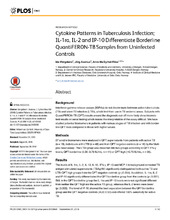| dc.contributor.author | Wergeland, Ida | en_US |
| dc.contributor.author | Assmus, Jörg | en_US |
| dc.contributor.author | Dyrhol-Riise, Anne Ma | en_US |
| dc.date.accessioned | 2017-06-07T07:09:16Z | |
| dc.date.available | 2017-06-07T07:09:16Z | |
| dc.date.issued | 2016-09-29 | |
| dc.Published | Wergeland I, Assmus J, Dyrhol-Riise AM. Cytokine Patterns in Tuberculosis Infection; IL-1ra, IL-2 and IP-10 Differentiate Borderline QuantiFERON-TB Samples from Uninfected Controls. PLoS ONE. 2016;11(9):e0163848 | eng |
| dc.identifier.issn | 1932-6203 | |
| dc.identifier.uri | https://hdl.handle.net/1956/15930 | |
| dc.description.abstract | Background: Interferon gamma release assays (IGRAs) do not discriminate between active tuberculosis (TB) and latent TB infection (LTBI), which limit their use in TB endemic areas. Subjects with QuantiFERON-TB (QFT) results around the diagnostic cut-off more likely show inconsistent results on serial testing which makes the interpretation of the assay difficult. We have studied potential biomarkers in patients with various stages of TB infection and with borderline QFT tests compared to those with higher values. Methods: 27 soluble biomarkers were analysed in QFT supernatants from patients with active TB (n = 18), individuals with LTBI (n = 48) and from QFT negative controls (n = 16) by the Multiplex bead assay. The LTBI group was classified into two groups according to QFT IFN-γ levels; QFT borderline (0.35–0.70 IU/mL, n = 11) or QFT high (>0.70 IU/mL, n = 36). Results: The levels of IL-1ra, IL-2, IL-13, IL-15, IFN-γ, IP-10 and MCP-1 in background corrected TB antigen stimulated supernatants (TBAg-Nil) significantly distinguished both active TB and LTBI QFT high groups from the QFT negative controls (p≤0.004). In addition, IL-1ra, IL-2 and IP-10 significantly differentiated the QFT borderline group from the controls (p≤0.001). Still, in the QFT borderline group the IL-1ra and IP-10 levels were not significant different from neither the QFT high nor the active TB group, whereas the IL-2 levels were lower (p≤0.003). The level of IP-10 showed the best separation between the QFT borderline group and the QFT negative controls (AUC 0.92) and offered 100% sensitivity for active TB. Conclusion: IL-1ra, IL-2 and IP-10 differentiate QFT borderline samples from uninfected controls and the majority of QFT borderline subjects were classified as LTBI by these markers. Still, inconsistency was seen, and further studies are needed to examine the performance of alternative markers before concluded if they could be used as diagnostics tools. | en_US |
| dc.language.iso | eng | eng |
| dc.publisher | PLOS | eng |
| dc.relation.ispartof | <a href="http://hdl.handle.net/1956/15932" target="_blank">Immune cells and soluble immune markers in different stages of tuberculosis. Potential biomarkers for diagnosis and treatment efficacy</a> | |
| dc.rights | Attribution CC BY | eng |
| dc.rights.uri | http://creativecommons.org/licenses/by/4.0 | eng |
| dc.title | Cytokine Patterns in Tuberculosis Infection; IL-1ra, IL-2 and IP-10 Differentiate Borderline QuantiFERON-TB Samples from Uninfected Controls | en_US |
| dc.type | Peer reviewed | |
| dc.type | Journal article | |
| dc.date.updated | 2017-05-09T12:51:01Z | |
| dc.description.version | publishedVersion | en_US |
| dc.rights.holder | Copyright 2016 The Author(s) | |
| dc.identifier.doi | https://doi.org/10.1371/journal.pone.0163848 | |
| dc.identifier.cristin | 1446280 | |
| dc.source.journal | PLoS ONE | |

